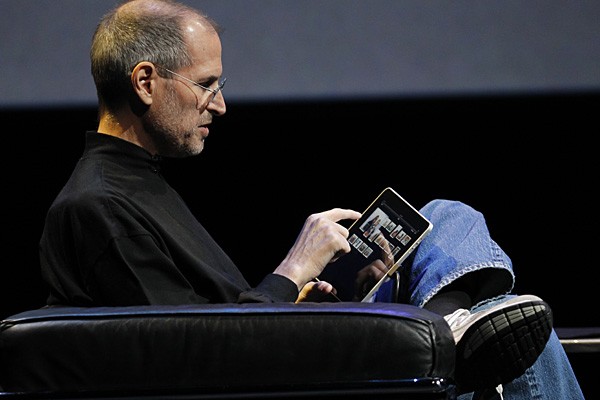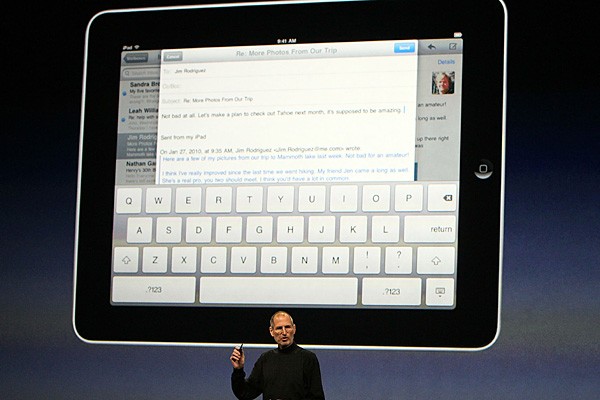
The iPad, and no doubt its future competitors, could fix a few things that really bug some travellers.
Starting with the size and capability gap between a Blackberry and a lap-top. Something like an iPad which is without a space consuming hinged lid, and has a screen big enough for a really decent touch screen alpha numeric keyboard solves a lot of issues for people with big clumsy fingers, especially in the confined space of a taxi or train if you are running late for a flight.

And especially if you go straight to the gate where you may be lucky even to find room to sit on the floor, because no-one, no-where, ever builds terminal facilities big enough to properly board your typical full 180 seat A320.
And while many of us don’t need a 15 inch screen to adequately read a document or presentation or news feed the display on a Blackberry is way too small, and not all that great on an iPhone.
Which raises coincidentally today’s announcement by Jetstar giving more details about how it will integrate booking details stored on a mobile phone with a new generation of check-in kiosks as part of its drive to become a 100% self serve carrier.
The relevant parts of the media release are pasted to the bottom of this post, however the phone-kiosk convergence means you won’t need to key anything in, you just put your hand held device into a tray or slot with the emailed booking code displayed, and it will print out your boarding pass and any checked baggage tags.
So, no-one expects to shove an iPad into a check-in kiosk. But isn’t Jetstar overlooking something as elegant as the proximity readers used on the likes of the Octopus public transport (and small purchase electronic purse) cards that are ubiquitous in Hong Kong for example? Instead of having to place the mobile phone IN the check-in kiosk, why not use a proximity reader to do the trick once you hold it say 10 cms away from the scan point you see on the tube and buses in London?
And while we are thinking about convergence between communications technology and the mass air travel movement, how about an app for iPhones and iPads that tracks and thus creates an audit trail for your flights and instantanously ports them to whichever frequent flyer account you are using at the time?
An audit trail that proves an airline owes you a fare credit when you miss a flight, so you can use it in part or full for a changed booking would make the chore of reconciling and accounting for your travel activity so much more efficient.
These things can be done now of course on your lap top, but probably done better and instantly, if the data is exchanged between your device and the new generation kiosk automatically, as you pause to pick up your boarding pass or checked bag sticker.
From the Jetstar announcement in Singapore today:
Jetstar will set about transforming the check-in experience for its Australian and New Zealand domestic customers during 2010 by unveiling a new approach towards the airport experience for customers with a target of 100 per cent customer self service.
The proposal builds upon existing customer self service technology now in place for Jetstar’s domestic passenger base including Web Check and Self Service Kiosks at some Airports.
This will be complemented by the introduction of world-first SMS Boarding Pass technology during the first 2010 quarter and automatic Web Check and pre-enrolment for flights at time of booking.
Jetstar passengers who Web-Check for Australian domestic flights will soon be given the option to have their boarding pass and unique boarding code sent to their mobile phone via a standard text SMS message.
The SMS technology has been developed by Melbourne-based company Sissit Group with which Jetstar has a Research and Development arrangement.
Unlike some other airlines who have introduced this technology to WAP (Wireless Application Protocol) or internet enabled handsets, in a global first, any mobile phone will be able to accept the Jetstar boarding pass on a domestic flight via the common text message.
This will allow customers who purchase fares via Jetstar.com to request at the time of booking for the airline to automatically check the passenger(s) in 24 hours prior to their Jetstar flight departure with the boarding pass to then be sent via email or SMS text message.
SMS boarding pass technology would be further trialled on Sydney-Melbourne (Avalon) flights from late February 2010, with a staged roll-out across Jetstar’s domestic Australian and New Zealand networks during the 2010 calendar year.
Automatic check-in when purchasing a fare at Jetstar.com had commenced earlier this month.
Automatic check-in for the airline’s Australian and New Zealand domestic services allows passengers at the time of booking to choose to check-in and have their boarding passes automatically sent to them via email 24-48 hours before flight departure.








Crikey is committed to hosting lively discussions. Help us keep the conversation useful, interesting and welcoming. We aim to publish comments quickly in the interest of promoting robust conversation, but we’re a small team and we deploy filters to protect against legal risk. Occasionally your comment may be held up while we review, but we’re working as fast as we can to keep the conversation rolling.
The Crikey comment section is members-only content. Please subscribe to leave a comment.
The Crikey comment section is members-only content. Please login to leave a comment.